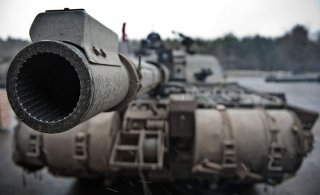Tank 'Shields' to Protect Against Enemy Missiles Are Now a Reality
APS, as they are called, have been developed, tested, refined, and built into vehicles for many years now to introduce new levels of survivability in armored warfare, something likely to increasingly be characterized by more and more advanced, long-range, and highly precise enemy anti-armor weapons being possessed by enemy forces.
Is there an Active Protection System that is fast enough--while also effective enough--against a wide sphere of incoming enemy attacks, and lightweight enough to integrate into a heavily armored vehicle that can succeed in addressing the Army’s evolving requirements for future mechanized combat?
APS, as they are called, have been developed, tested, refined, and built into vehicles for many years now to introduce new levels of survivability in armored warfare, something likely to increasingly be characterized by more and more advanced, long-range, and highly precise enemy anti-armor weapons being possessed by enemy forces.
The technology, some elements of which date back as far as 20 years, involves the use of highly sensitive sensors to detect incoming RPG or Anti-Tank Guided Missile fire, identify the location, trajectory and expected impact point with computer-enabled fire control algorithms and then fire out an “interceptor” projectile to intercept, explode or simply “knock out” the incoming round before it impacts a vehicle.
Over the years, many interactions and applications of these kinds of systems have been demonstrated with great degrees of success, some of them such as Raytheon’s Quick Kill hemispheric interceptor system dating back as far as the Army’s Future Combat Systems program. The promise of APS, as part of an integrated suite of sensors called a “survivability onion” at the time, in large measure inspired the conceptual basis for engineering lightweight, deployable 27-ton Manned Ground Vehicles. While those vehicles did not come to fruition, the fundamental mission persists with great vigor today.
This phenomenon, which could even be called a predicament of sorts, informs current Army efforts to architect a new generation of APS architecture called Modular Active Protection Systems. The intent is to engineer the technical infrastructure needed to build and integrate new, lightweight, adaptable APS systems sufficient to propel armored warfare into the future.
Some recent APS technologies, which have in recent years been tested on armored vehicles such as Bradley infantry carriers and Abrams tanks include The Trophy System, Iron Fist, and Iron Curtain, however, while many assessments show great promise and effectiveness, the Army is still seeking new technical paradigms for APS.
“We still have a ways to go with APS. It is about the architecture, right? A technical “brain” which will control any effector and any sensor. We can pick the best sensor available and integrate it. At the same time the Abrams is going to be around for a while. It is still the best tank in the world, and APS can add weight to a tank,” Gen. John Murray, Commander, Army Futures Command, told The National Interest in an interview.
Kris Osborn is the defense editor for the National Interest. Osborn previously served at the Pentagon as a Highly Qualified Expert with the Office of the Assistant Secretary of the Army—Acquisition, Logistics & Technology. Osborn has also worked as an anchor and on-air military specialist at national TV networks. He has appeared as a guest military expert on Fox News, MSNBC, The Military Channel, and The History Channel. He also has a Master’s Degree in Comparative Literature from Columbia University.

